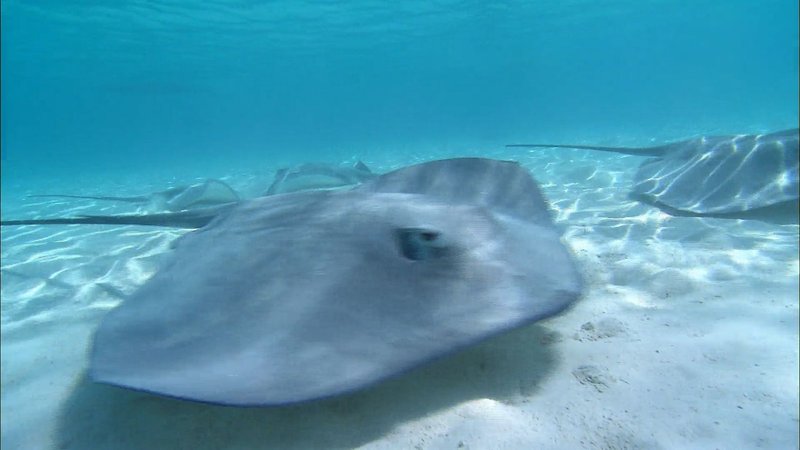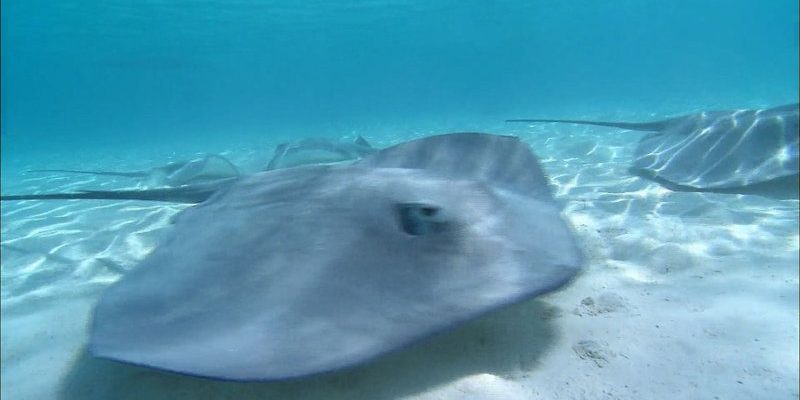
Stingrays aren’t just ocean dwellers; they can be found in various aquatic environments, from salty seas to freshwater rivers. Understanding where stingrays call home can help us appreciate their role in the ecosystem and the interesting behaviors they exhibit. Let’s uncover the different places where you might encounter these unique creatures.
Stingray Species and Their Habitats
There’s a whole world of stingray species out there, each with its own preferences for living conditions. For instance, the Southern Stingray is often found in shallow coastal waters, while the Freshwater Stingray makes its home in rivers and lakes. Let’s dive into a few prevalent species and where they typically hang out.
- Southern Stingray: Commonly found in the shallow waters of the Caribbean Sea and along the southeastern United States, they love sandy bottoms where they can camouflage.
- Atlantic Stingray: This species prefers estuaries and coastal waters, often venturing into shallow bays and lagoons.
- Freshwater Stingray: You might find these fascinating creatures in the Amazon River, where they roam in slow-moving waters and muddy bottoms.
Each species has adapted to its environment, showcasing how diverse stingrays are within the aquatic world. Honestly, it’s fascinating to think that despite their similarities, these creatures have carved out their unique niches.
Oceans: The Stingray’s Playground
Most people associate stingrays with oceans, and for a good reason! The vast majority of stingray species are marine animals. They thrive in warm waters, particularly in tropical and subtropical regions. Coastal areas are their favorite spots, where the water is shallow enough for them to forage for food.
In the ocean, stingrays often inhabit reefs, sandy bottoms, and mudflats. Here’s the thing—these environments are perfect for them to hide from predators and hunt for prey like crabs, clams, and small fish. You might even find them basking in the sun on the ocean floor, blending in seamlessly with their surroundings.
As they glide gracefully through the water, they can travel considerable distances in search of food or a mate. Some species, like the Manta Ray, can even be found in deeper waters, showcasing their incredible adaptability.
Estuaries: A Mixing Pot of Fresh and Saltwater
Estuaries are some of the most dynamic environments for stingrays. Here, saltwater from the ocean mixes with freshwater from rivers, creating a unique habitat teeming with life. These areas are often rich in nutrients, making them ideal feeding grounds for stingrays.
The Atlantic Stingray, for example, often finds itself in estuarine environments. These habitats are essential for their lifecycle, offering areas to breed and find food. It’s not uncommon to see stingrays swirling in the muddy waters, looking for small fish or crustaceans to snack on.
What’s fascinating is that the fluctuating salinity in these environments means stingrays can adapt and thrive in different water conditions. It’s like visiting a restaurant offering both your favorite coffee and a fresh seafood platter—all in one place!
Freshwater Habitats: A Surprising Home for Some Species
You might be surprised to learn that not all stingrays live in saltwater. Some species, like the Freshwater Stingray, reside in rivers, lakes, and even floodplains. The Amazon River is particularly famous for its rich biodiversity, including these unique rays.
Freshwater stingrays enjoy the murky waters of large rivers, where they can easily hide from predators and hunt for food. Their flat bodies allow them to stay close to the riverbed, sifting through the sand and mud for crustaceans or smaller fish. It’s an entirely different lifestyle compared to their oceanic relatives, but they thrive just the same.
You might be wondering how these stingrays manage in freshwater. They possess specific adaptations, like specialized gills, that allow them to filter out oxygen more efficiently in less salty environments. It’s a remarkable example of how creatures can evolve to fit their habitats!
Coastal Waters and Bays: Safe Havens
Coastal waters and bays act like safe havens for many stingray species. These areas often feature shallow waters, which provide plenty of places for stingrays to hunt while avoiding larger predators like sharks. The sandy and muddy bottoms typically found here are perfect for burying themselves, allowing them to become nearly invisible while they wait for unsuspecting prey.
In addition to hunting grounds, these coastal regions often serve as nurseries for younger stingrays, offering protection until they’re big enough to venture into deeper waters. It’s like having a cozy home base for growing up.
When you think about stingrays, imagine a toddler exploring a safe play area with plenty of toys. That’s what these bays and coastal waters provide for young stingrays. It’s a crucial part of their life cycle, ensuring that the population can continue to thrive.
Conservation and the Importance of Stingray Habitats
As we explore where stingrays are found, it’s essential to consider the health of their habitats. Many stingray species face threats from overfishing, pollution, and habitat loss. This can disrupt their ecosystems, leading to a decline in their populations.
Conservation efforts are crucial in protecting these habitats and ensuring future generations can continue to enjoy the beauty of stingrays. Organizations work tirelessly to advocate for cleaner waters and better fishing practices that won’t harm these creatures’ living environments.
By understanding where stingrays are found, we can actively participate in their protection. This can be as simple as practicing responsible fishing, reducing plastic use, or supporting conservation efforts in your area. Every little bit helps!
Final Thoughts on Stingray Habitats
So, where are stingrays found? From the glistening oceans to the winding rivers and estuaries, these incredible creatures have adapted to a variety of habitats. Whether they’re cruising along coral reefs, hiding in the muddy bottoms of rivers, or exploring the dynamic environments of estuaries, stingrays showcase the beauty of nature’s diversity.
Understanding their habitats isn’t just interesting; it’s essential for their conservation and the health of our aquatic ecosystems. Next time you’re at the beach or near a river, think about the stingrays that might be living nearby, each playing its role in the delicate balance of our environment. Let’s appreciate and protect these beautiful creatures for years to come!

